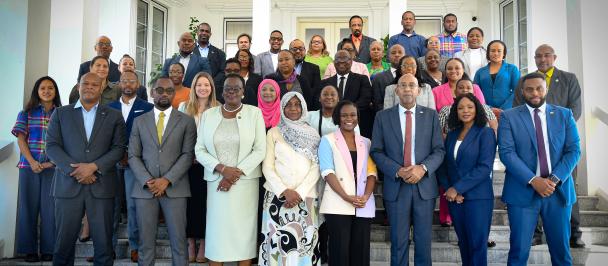Workers under the UNDP Emergency Emplotment
No one expected that a rouge “flu” would have crippled the world. Least of all the countries of the Caribbean, thousands of miles away from the epicenter of the COVID-19 virus. The idyllic nation of St Vincent and the Grenadines (SVG) know for pristine waters and blockbuster pirate films would soon feel the harsh socio-economic effects of restricted travel, business closures and lockdowns. Like the rest of the region SVG was playing a balancing act with its economy and its health care system as it strived to recover from this global pandemic and then the La Soufrière volcano erupted.
The eruptions of the La Soufrière volcano began on 9 April with several smaller eruptions continuing after the initial explosion, displacing close to 20,000 persons. Entire villages were covered in ashes, buildings damaged, schools and businesses closed, crops and livestock destroyed, and residents left with limited access to clean drinking water. This catastrophic event, which only exacerbated the current tenuous state of the St Vincent and Grenadines could no doubt be considered a stumbling stone, but the resilience of the Caribbean is as steady as it is strong. This event would be used instead as the first block to build forward better. The government with the support of UNDP Barbados and the Eastern Caribbean, other UN Partners and developmental agencies responded to the eruption of La Soufrière volcano with a comprehensive 3 pillar recovery strategy.
UNDP coordinated the acquisition of personal protective equipment (PPEs) and tools to be used in the removal of volcanic ash from critical areas that allowed the island to start the journey to recovery. Two weeks after the explosive eruptions and even before the airport reopened, supplies started to arrive on island via the seaport to support the Emergency Employment Programme tied to ash removal which trained teams and dispersed equipment for a May 31st roll out.
In collaboration with the Buildings, Roads and General Services Authority (BRAGSA) the ash removal programmed was fully functional throughout the month of June with two sets of teams working in both the northeast and northwest of the island within the Orange zones: providing temporary employment to approximately 120 persons (65 men, 55 women). A gender lens was applied to all aspects of the project and the worker-selection process used an inclusive criterion to ensure that not less than 40% of the employees were women, with specific priority being given to women who headed their households. Persons were chosen from the zone in which clean-up was being done, these communities included Georgetown, Langley Park, and Dixon and Spring Village, Troumaca, Rose Hall and Rose Bank. One beneficiary of the programme stated, "As a single mother I am very grateful to the UNDP and BRAGSA for offering me the opportunity to gain employment under the programme to clean the institutions around Georgetown as there were no other forms of employment due to the eruption of La Soufriere."
Within a month, the ash removal team had cleaned ten schools (two secondary and eight primary) allowing more than fifteen hundred (1,500) students to return to the classroom. The team also cleaned three churches, a convent, the St. Benedicts home for children and power washed the homes of a number of elderly persons in the surrounding communities who required assistance. Teams removed in excess of 15,000 cubic yards of ash from schools, foot paths and churches in the orange zone to help communities rebuild and recover.
This 3-pillar recovery strategy which also includes household and building damage assessments restoration and the regeneration of forestry, watersheds and protected areas damaged by the eruption is part of the work of UNDP Barbados and the Eastern Caribbean in its commitment to promoting economic diversification, job creation and resilience under a "Blue Economy for Green Islands" approach. As St. Vincent and the Grenadines continues to seek innovative solutions to build resilience and ensure livelihoods for traditionally vulnerable groups, UNDP Barbados and the Eastern Caribbean, in partnership with the government and stakeholders, remains dedicated to the advancement of inclusive and sustainable development and building resilient communities that can withstand shocks and crises through targeted projects and programmes.

 Locations
Locations



